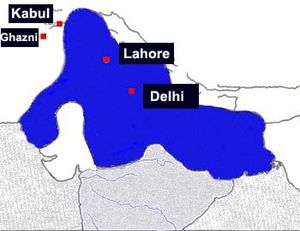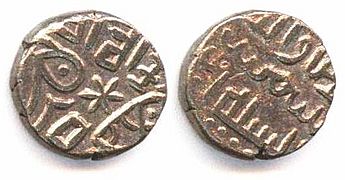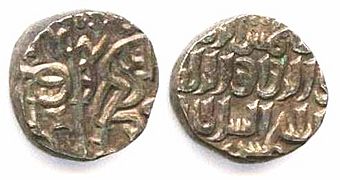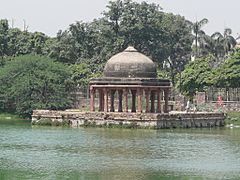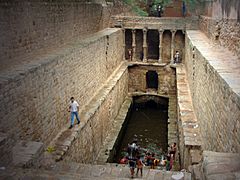Iltutmish facts for kids
Quick facts for kids Shams-ud-Din Iltutmish |
|
|---|---|
| Sultan | |
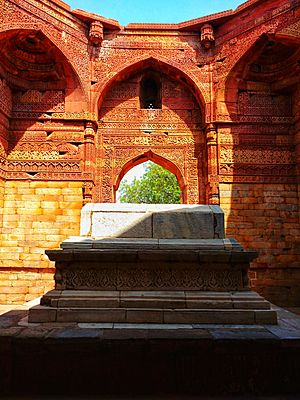
Illtumish Tomb in Qutub Minar Complex
|
|
| 3rd Sultan of Delhi | |
| Reign | June 1211 – 30 April 1236 |
| Predecessor | Aram Shah |
| Successor | Rukn ud din Firuz |
| Born | unknown Central Asia Ilbari Turkic tribe |
| Died | 30 April 1236 Delhi, Delhi Sultanate |
| Burial | Qutb Complex, Mehrauli, Delhi |
| Spouse | Turkan Khatun, a daughter of Qutub-ud-din Aibak (Chief consort)
Shah Turkan Malikah-i-Jahan |
| Issue | Nasiruddin Mahmud Raziya Sultana Muiz ud din Bahram Ruknuddin Firuz Nasiruddin Mahmud Shah (possibly a grandson) Ghiyasuddin Muhammad Shah Jalaluddin Masud Shah Shihabuddin Muhammad Qutbuddin Muhammad unnamed daughter Shazia Begum |
| Father | Ilam Khan |
| Religion | Sunni Islam |
Shams ud-Din Iltutmish (died 30 April 1236) was an important ruler in northern India. He was the third of the Mamluk kings who ruled parts of India. He is known as the real founder of the Delhi Sultanate, as he was the first Muslim ruler to make Delhi his capital. His name "Iltutmish" means "maintainer of the kingdom" in Turkic.
Iltutmish started his life as a slave. He was sold when he was young and lived in cities like Bukhara and Ghazni. Later, Qutb ud-Din Aibak, another slave-commander, bought him in Delhi. Iltutmish quickly became important in Aibak's service. He was given charge of the important area of Badaun. His brave actions in battles, like against the Khokhar rebels, caught the attention of the Ghurid ruler Muhammad of Ghor. Muhammad of Ghor even set Iltutmish free before his own master, Aibak, was freed.
After Muhammad of Ghor died in 1206, Aibak became an independent ruler in India. When Aibak died in 1210, Iltutmish took over from his unpopular successor, Aram Shah, in 1211. He then made Delhi his capital. He worked hard to bring different parts of the kingdom under his control. He fought against other former Ghurid slaves who had become powerful, like Taj al-Din Yildiz and Nasir ad-Din Qabacha. He also took back control of areas in eastern India and places like Ranthambore and Mandore, whose local rulers had declared independence.
In the 1220s, Iltutmish mostly stayed away from the Indus Valley region, which was full of conflicts. But in 1228, he invaded that region, defeated Qabacha, and added large parts of Punjab and Sindh to his empire. Later, the Caliph in Baghdad officially recognized his rule in India. Over the next few years, Iltutmish put down a rebellion in Bengal, captured Gwalior, and raided cities in central India.
Iltutmish was very important in organizing the Delhi Sultanate. He created a strong system that helped the Sultanate rule northern India for a long time. He introduced new coins: the silver tanka and the copper jital. These became the main coins for the Sultanate. He also set up the iqta' system. This system divided the empire into areas called iqtas, which were given to nobles and officers instead of salaries. He also built many important structures, including mosques, monasteries (khanqahs), shrines (dargahs), and a large water reservoir (hawz).
Contents
Early Life and Rise to Power
Growing Up Outside India
Iltutmish was born into a wealthy family. His father, Ilam Khan, was a leader of the Ilbari Turkic tribe. Stories say he was a smart and good-looking boy. Because of this, his brothers became jealous and sold him to a slave dealer.
As a young boy, Iltutmish was taken to Bukhara. There, he was sold again to a religious official. He was very interested in religious studies. One story tells how he lost money meant for grapes. A holy man (dervish) helped him and asked him to promise to be kind to religious people when he became powerful. Iltutmish also spent time in Baghdad, where he met famous Sufi mystics.
Later, Iltutmish was sold to a merchant who brought him to Ghazni. The Ghurid king, Muhammad of Ghor, heard about him and tried to buy him. But the merchant refused.
Serving Qutb al-Din Aibak
Eventually, Iltutmish's master brought him to Delhi. There, Qutb al-Din Aibak, a powerful slave-commander of the Ghurid king, bought Iltutmish. Iltutmish quickly moved up in Aibak's service. He became the head of the bodyguards and then the superintendent of the hunt.
After the Ghurids conquered Gwalior in 1200, Iltutmish was made the governor of that town. Later, he was given charge of Badaun, which was a very important area. His good leadership led to him being given a special honor by Sultan Mu'izz ad-Din. The Sultan even ordered Iltutmish to be set free, even before his own master Aibak was freed.
Becoming Sultan and Securing His Rule
Taking the Throne in Delhi
After Mu'izz ad-Din died in 1206, Qutb al-Din Aibak became the ruler of the Delhi Sultanate. In 1210, Aibak died suddenly. Local nobles in Lahore chose Aram Shah as the new ruler. But nobles in other parts of the Sultanate did not agree. They wanted Iltutmish to be the ruler because Aibak had treated him like a son.
These nobles invited Iltutmish to take the throne. Iltutmish marched to Delhi, took control, and defeated Aram Shah's forces. Some nobles tried to rebel against him, but Iltutmish defeated them and strengthened his power.
After Aibak's death, the Ghurid lands in India were split into four main parts:
- Delhi, controlled by Iltutmish.
- Sindh, controlled by Nasir ad-Din Qabacha.
- Lakhnauti (in eastern India), controlled by Ali Mardan Khalji.
- Lahore, which was fought over by Qabacha, Taj al-Din Yildiz, and Iltutmish.
Dealing with Rivals
Many Muslim officers who had worked for Aibak did not accept Iltutmish's rule at first. Iltutmish had to fight several campaigns to bring areas like Badaun, Awadh, and Banaras back under Delhi's control.
The Hindu chiefs in places like Ranthambore and Jalor had also declared independence. Iltutmish had to deal with these challenges as well.
Defeating Yildiz
Taj al-Din Yildiz, a former slave, controlled the Ghurid capital of Ghazni. He claimed to be the rightful ruler of all former Ghurid lands, including India. Yildiz sent gifts to Iltutmish, suggesting that Iltutmish was his subordinate. Iltutmish accepted the gifts to avoid immediate conflict.
However, Yildiz was forced out of Ghazni by an invasion. He moved east and took Lahore from Qabacha. Iltutmish worried that Yildiz would try to take Delhi next. So, Iltutmish marched against him. They fought a battle at Tarain in January 1216. Iltutmish won, and Yildiz was captured and later killed. This victory was very important because it confirmed that the Delhi Sultanate was truly independent.
Conflicts with Qabacha
After defeating Yildiz, Iltutmish did not immediately take over all of Punjab. Qabacha regained control of Lahore. Qabacha had become a powerful ruler, controlling a large area including Sindh and Multan.
In 1217, Iltutmish marched against Qabacha. Iltutmish's army chased and defeated Qabacha near the Chenab River. Iltutmish then captured Lahore and appointed his son, Nasiruddin Mahmud, to govern it.
The Mongol Threat
In the early 1220s, the powerful Mongols invaded the lands to the west of India. The Khwarazmian ruler, Jalal ad-Din Mingburnu, fled to the Punjab region after being defeated by the Mongols. He tried to form an alliance with Iltutmish against the Mongols.
Genghis Khan, the Mongol leader, sent envoys to Iltutmish, asking for permission to pass through India. Iltutmish seems to have agreed not to help Jalal ad-Din. He refused to give Jalal ad-Din a place to stay in his kingdom. Iltutmish wisely avoided a direct conflict with the Mongols. He stayed out of the Indus Valley region until Genghis Khan died in 1227.
Expanding the Empire
Conquering Eastern India and Rajasthan
In eastern India, the governor Ghiyasuddin Iwaj Shah had declared independence. He had even taken parts of Bihar and collected tribute from other small states. Iltutmish's forces captured Bihar in the 1210s. In 1225, Iltutmish invaded Bengal. Ghiyasuddin agreed to pay tribute and accept Iltutmish's rule to avoid a fight. Iltutmish accepted and returned to Delhi.
In 1226, Iltutmish captured the strong Ranthambore Fort in Rajasthan. The next year, he captured the fort of Mandore in the same region.
Later, Ghiyasuddin in Bengal again declared independence. In 1227, Iltutmish sent his son, Nasiruddin Mahmud, to invade Bengal. Nasiruddin captured the capital, Lakhnauti, and defeated Ghiyasuddin. After this victory, coins in Bengal were made in Iltutmish's name, showing his full control.
Taking Over Qabacha's Lands
After the Mongol threat lessened, Qabacha became very powerful in the Indus River Valley. In 1228, Iltutmish decided to invade Qabacha's territory. Qabacha's power had been weakened by earlier conflicts.
Iltutmish's forces captured several areas from Qabacha, including Lahore. Iltutmish then sent his general to capture Multan, while he himself besieged Uch. Iltutmish captured Uch after a three-month siege in May 1228.
Qabacha fled, but Iltutmish's army pursued him. Finding no way out, Qabacha died in May 1228. Iltutmish then took control of Multan and Uch. His empire now stretched all the way to the Arabian Sea.
Later Years and Legacy
Recognition from the Caliph
In 1228, the Caliph in Baghdad, Al-Mustansir, sent an ambassador to Delhi. In February 1229, the ambassador arrived with special robes and a document. This document officially recognized Iltutmish as the ruler of India. It also gave him important titles like "Right Hand of God's Deputy."
This recognition was very important for Iltutmish. It showed that he was an independent ruler, not just a subordinate. Iltutmish celebrated this event by decorating Delhi and honoring his officials. He was the only ruler in India to receive such official recognition from the Caliph. After this, Iltutmish started putting the Caliph's name on his coins.
Other Military Actions
In 1229, Iltutmish's son, Nasiruddin Mahmud, who was governing Bengal, died. An officer named Malik Balkha Khalji took control of Bengal. Iltutmish invaded Bengal in 1230 and defeated him.
In 1231, Iltutmish besieged Gwalior in central India. He captured it after 11 months. In 1233–1234, his officers attacked the Chandela fort of Kalinjar, getting a lot of treasure.
Iltutmish also raided the cities of Bhilsa and Ujjain in 1234–35. His army destroyed a temple in Bhilsa and damaged the Mahakaleshwar temple in Ujjain.
Death and Succession
In 1236, Iltutmish became ill during a military campaign. He returned to Delhi and died on 30 April 1236. He was buried in the Qutb complex in Mehrauli.
After Iltutmish's death, there were many years of political problems in Delhi. Several of his descendants ruled for short periods and were then overthrown. Iltutmish had planned for his eldest son, Nasiruddin Mahmud, to be his successor, but Nasiruddin died in 1229.
While Iltutmish was away on a campaign in 1231, he left his daughter, Razia, in charge of Delhi. She managed things very well. Because of this, Iltutmish decided to name her as his heir. However, just before he died, he seemed to have chosen his son, Ruknuddin Firuz, as his successor.
When Iltutmish died, the nobles chose Ruknuddin as the new king. But Ruknuddin's mother, Shah Turkan, took control and treated rivals badly. This led to rebellions. In November 1236, Razia took the throne with public support. She was the first and only female ruler of the Delhi Sultanate. However, she was also overthrown and killed in 1240.
Order was finally restored in 1246 when Nasiruddin-Mahmud became Sultan. He appointed Iltutmish's powerful slave, Ghias-ud-din-Balban, as his deputy. Balban held all the power and later became Sultan himself in 1266.
Contributions and Achievements
Organizing the Army and Administration
Iltutmish was likely the first ruler to create a centrally organized army in the Delhi Sultanate. This meant the army was recruited, paid, and managed by the central government. His courtier, Fakhr-i Mudabbir, even wrote a book on warfare during his reign.
The Iqta System
Iltutmish put the iqta' system into practice in the Delhi Sultanate. This system was borrowed from older Islamic empires. It involved giving control of land and its revenues to officers in exchange for their military service and loyalty. Iltutmish used this system to strengthen his empire.
He gave large iqtas to high-ranking officials. These officials were expected to govern their areas, keep law and order, and provide soldiers when needed. Smaller iqtas were given to others who collected taxes and provided military service. To make sure the system stayed fair and loyal to the Sultan, Iltutmish often moved iqta holders from one region to another. This prevented them from becoming too powerful in one place.
New Coins
Iltutmish introduced two important coins that became the standard for the Delhi Sultanate: the silver tanka and the copper jital.
Before him, rulers used local coins. But Iltutmish faced a shortage of silver. So, he created a new system with an 11-gram silver tanka and a copper jital with a small amount of silver. This new system became the basis for coinage for a long time. The tanka is even seen as an early version of the Rupee.
- Coins of Iltutmish
Promoting Islamic Culture
During Iltutmish's rule, Delhi became a major center of Islamic power and culture in India. He supported many scholars and Sufi mystics. Many learned people came to Delhi, especially from Persia, which was being invaded by the Mongols.
Iltutmish's court was known for respecting scholars and saints. He even had special raised seats for them. This shows how much he valued knowledge and religious figures.
Architecture and Buildings
Iltutmish invested in many public works in Delhi, including water systems, mosques, and other buildings. He finished the construction of the Qutb Minar, which had been started by Qutb al-din Aibak. He also ordered the building of the Hauz-i-Shamsi reservoir and a school (madrasa) around it.
He built several monasteries (khanqahs) and shrines (dargahs) for Sufi saints. He started the building of Hamid ud-din's Khanaqa and built the Gandhak ki Baoli, a stepwell, for the Sufi saint Qutbuddin Bakhtiar Kaki.
In 1231, he built the Sultan Ghari monument for his eldest son, Nasiruddin, who had died two years earlier. This was the first Islamic tomb in Delhi.
-
Qutb Minar was completed by Iltutmish
Family Life
Iltutmish had several wives and many children. His chief wife was Turkan Khatun, the daughter of Qutb ud-Din Aibak. She was the mother of his eldest son, Nasiruddin Mahmud, and his famous daughter, Razia Sultana.
Another important wife was Shah Turkan, who was the mother of Ruknuddin Firuz. She became very powerful after Iltutmish's death.
Iltutmish had many sons and daughters. Some of his notable children include:
- Malik-us-Sa'id Nasiruddin Mahmud (died 1229): His eldest son, whom he had hoped would succeed him.
- Sultan Ruknuddin Firuz (executed 1236): Appointed as successor but ruled briefly.
- Sultan Muizuddin Bahram Shah (killed 1242): Another son who became Sultan.
- Razia Sultana (died 1240): His daughter, who became the first female Sultan of Delhi. She was known for her strong leadership.
- Nasiruddin Mahmud Shah (died 1266): A later Sultan, possibly a grandson, who brought stability back to the Sultanate.
See also
 In Spanish: Iltutmish para niños
In Spanish: Iltutmish para niños


